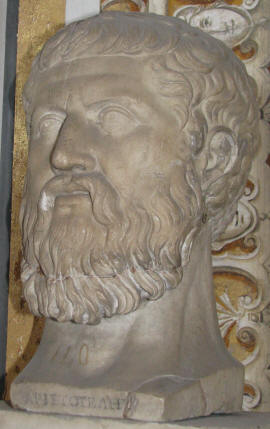An Aristotelian Hangover
Dec
01, 2009
The astronomers responsible for
the news feeds in our tabloids seem
to have a profound disliking for the
idea that the solar system,
including the earth, has suffered
catastrophic changes within the past
few thousand years.
This intellectual
preference is never explicitly
stated. It rather acts on the
unconscious mindsets of
theoreticians, for example when
evidence for cratering on the
planets is immediately, without a
second thought, relegated to the
eventful ‘early days’ of the solar
system; when the possibility of
unpredictable fluctuations in the
planetary orbits is tacitly ignored;
or when the pioneering work of
plasma physicists like Kristian
Birkeland or Hannes Alfvén does not
rate a mention in standard textbooks
on astronomy.
What causes otherwise intelligent
thinkers to shut off their minds for
alternatives that seem genuinely
possible, if not perfectly viable? A
conspiracy? Ill will? Naivety? Or an
intellectual blind spot? From a
historical point of view, the legacy
of Aristotle may prove very
instructive.
In his dialogues, Aristotle’s
teacher, Plato, had happily
speculated about cyclical episodes
of destruction both on earth and on
a cosmic level. One of his main
interests was to incorporate ancient
traditions about a reversal of the
sun, a worldwide flood or a
consuming fire into models that made
scientific sense. For Plato, the
realm of absolute, immutable
perfection was not that of the stars
and planets, but lay outside the
material world altogether.
His junior, Aristotle, would have
none of this. Downplaying any
traditions about global floods and
fires, Aristotle regarded the
spheres of stars and planets
themselves as unalterable, immune to
any form of decay or change. To such
lengths would he go that even comets
were removed from their place among
the planets and relegated to the
‘elemental’ region below the moon,
where meteors and auroras belong! If
Plato had no qualms to contemplate
catastrophes, Aristotle was an
out-and-out uniformitarian thinker –
a contrast lucidly discussed by the
British historian, Peter James,
among others.
Intriguingly, this change in
sentiments seems to have repeated
itself on a larger scale among
post-medieval scholars in Europe.
When Renaissance savants first
rediscovered Greek literature,
Platonic philosophy was all the
mode, often tinged with Gnostic or
Hermetic notions. During this time,
the likes of William Whiston and Sir
Edmond Halley felt no compunction to
entertain the thought of comets
precipitating the global flood of
Noah or the tilting of the
rotational axis.
The seeds for change were sown when
Gottfried Leibniz, a cardiac
Aristotelian, declared with
overweening confidence that
natura non facit saltus, ‘nature
does not make a leap’, and worked
with zeal on the theory of a great
continuous ‘chain of being’ that
would join all forms of life. This
anti-catastrophist attitude
snowballed into a movement
culminating in the 19th century in
the paradigms of steady evolution
championed by Charles Lyell, Charles
Darwin and a host of minor figures,
which overshadowed any remaining
catastrophists completely.
On a big-picture view, the course of
western science since then can be
seen as an on-going effort to
liberate the study of transient
events in space from the obfuscating
clutches of latter-day
Aristotelians. The reality of
meteorite falls continued to be
denied as late as 1833. Sunspots
long sat uncomfortably with many who
preferred an ‘unblemished’ sun and
Herschel’s claim that sunspots may
have an effect on terrestrial
weather and climate continued to be
vociferously opposed even in the
early 20th century.
More recent developments in
astronomical theory can be seen in
the same light. Comet impacts
remained taboo until Alvarez &
Alvarez identified iridium in the
extinction layer of the Dinosaurs in
1980. When comet Shoemaker-Levy 9
visibly impacted on Jupiter in 1994,
any illusions that impacts only
occurred millions of years in the
past were firmly dispelled.
Nevertheless, many astronomers carry
on minimising the odds that the
earth is hit by a Near-Earth Object
(NEO) – but for how long? Evidence
that the solar system is a highly
structured electromagnetic apparatus
continues to roll in and it may not
be long before the full implications
of a universe driven by plasma must
be faced by all.
Mathematicians deserve much of the
blame for the Aristotelian inertia
that has obstructed progress for so
long. Leibniz was a mathematician;
the findings of Richard Carrington
and Kristian Birkeland, since proven
true, were mainly opposed with
mathematical arguments; and today’s
astronomers have a penchant for such
mathematical fantasies as string
theory, black holes, Big Bang
analysis, and so on, which prevent
any genuine understanding of the
universe.
This state of affairs is hardly
surprising. By nature,
mathematicians are attracted to
numerical precision, regularity and
a cosmos running with a clockwork
stability. For those with an
instinctive visceral aversion to
phenomena that are irregular,
unpredictable or hard to measure and
calculate, a universe with cometary
intrusions, planets prone to orbital
adjustments and stars of which the
age and distance cannot be
confidently inferred must be a
nightmare.
Who is to say nature cares about a
propensity for human number games? A
scientist deserving of the name must
bow to observational evidence and
accept that good observations and
traditions take precedence over
theoretical preferences. Maths must
be ancillary, not dominant, as the
intellectual stupor of the
Aristotelian outlook gives way to a
Platonic curiosity and acceptance of
what is.
Contributed by Rens Van der Sluijs
www.mythopedia.info
Further Reading:The Mythology of the
World Axis; Exploring the Role of
Plasma in World Mythology
www.lulu.com/content/1085275
The World Axis as an Atmospheric
Phenomenon
www.lulu.com/content/1305081
|








